Banana @ Eden
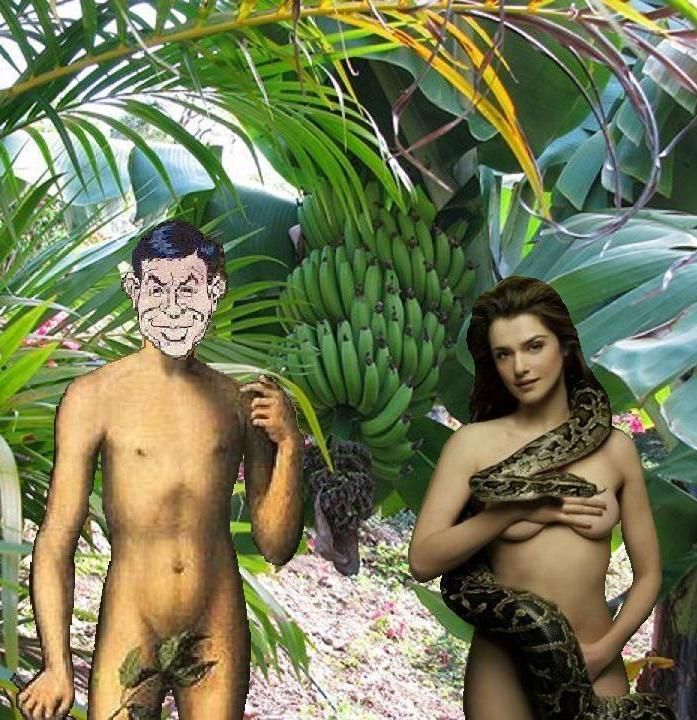
(banana82e.jpg)
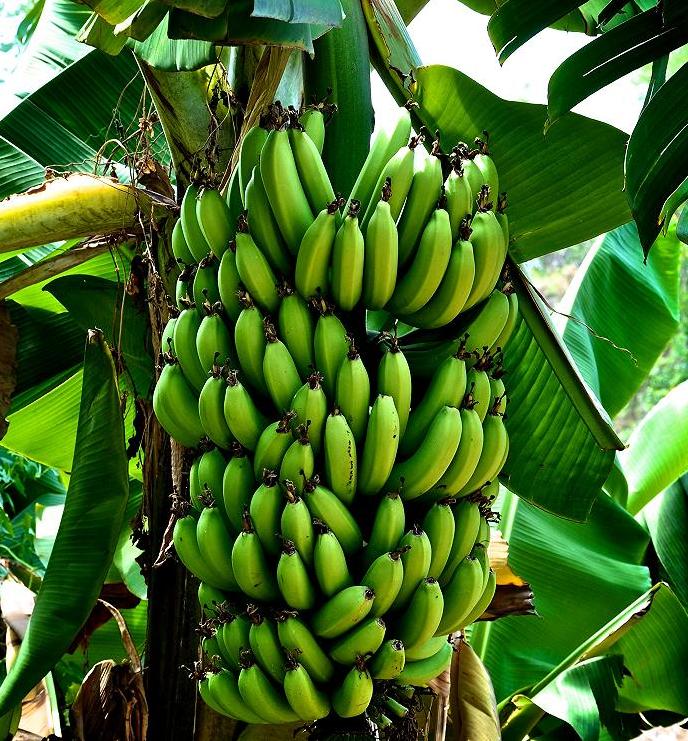
(banana83b.jpg)
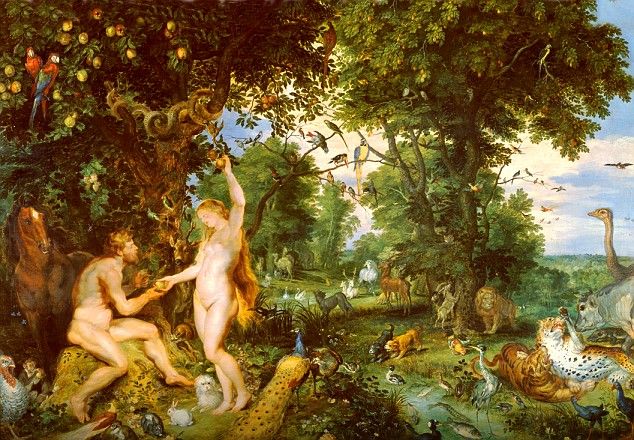
(garden01.jpg)

Kato, did you dream of eating a banana in the Garden of Eden last night?

No, I didn't.
Then how come you pasted the above picture? You and Eve seems to have found a lot of bananas in such a romantic dream.
Diane, have you ever heard of a true story in which Adam and Eve ate a banana instead of an apple?
No kidding!
I'm not joking nor jesting. I'm dead serious!
Kato, are you out of your mind? All the Christians have been believing for centuries that Adam and Eve ate an apple in the Garden of Eden. If you say this nonsense, you're gonna be a laughingstock on the Net.
I know, I know..., but what I'm saying is true.
You must be out of your mind, Kato. Why don't you wake up and wash your face again in the ice-cold water?
So, Diane, you don't believe me, do you?
Nobody believe you, Kato. What the heck makes you think so?
Actually, I borrowed a translated version of the best-seller called "Banana."
I see ... so you've simply gone bananas after reading it, haven't you?
Well ... Diane, at least, you've got a good sense of humor ...
Kato, do you really believe such a foolish story?
No, this isn't a foolish story. Look at the following catalogue page.

(lib30610.gif)
■“Actual Library catalogue”
I see... so, Kato, you've read the Japanese version, haven't you?
Yes, I have. The above book is one of the best non-fiction books I've ever read in my life.
Do you really mean it, Kato?
Yes, of course, I do. Why don't you borrow and read it once the library acquires it.
Kato, have you already reserved it?
Oh, yes, I have. By the way, Diane, do you know who told the world in the first place that Adam and Eve ate an apple in the Garden of Eden?
... beats the hell out of me, but it is common sense, isn't it?
The book says, the first person said that is Saint Jerome.
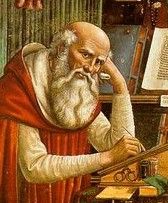
(hiero02.jpg)

This man was born in Dalmatia in 340 AD. Parents were Christians, but he wasn't interested in Christianity himself. He went to Rome simply because he wanted to study philosophy and rhetoric.

Then why did he get involved in the Bible?
Good question! ... While he studied Greek and devoted himself to the study of classics in Anatolia and Gaul, he got seriously ill around 373, in Antioch. This illness made him devote his life to the study of theology. Then he learned Hebrew while living in the desert of Syria, and decided to immerse himself in a project to translate the old Bible into Latin. The book also tells the following story.
The Pope ordered Jerome to translate the Bible, and he just did it in Rome.
After this translation, the Bible came to be read by more people.
During the following six centuries, the Bible began to be translated in other languages.
Then, in 1455, Johannes Gutenberg invented the printing machine, which made it possible that the Bible came to be printed in large quantities for the first time.
The Gutenberg Bible was an exact copy of the faithful Latin translation made by Jerome a thousand years ago.
As in English, Latin is a language in which there are homonyms that share the same pronunciation but have different meanings.
When Jerome translated the Hebrew word "fruit of knowledge of good and evil" into Latin, he picked “malum” for it.
According to the biblical archaeologist Shuneia Levin, its meaning is close to "malicious."
“Malum” can also be translated as "apple" since it is a word derived from the Greek word "melon" that originally maens "apple."
The Renaissance painters who read the Gutenberg Bible interpreted the word to refer to apple, and began to draw an apple, instead of a banana, in a picture of the Garden of Eden.
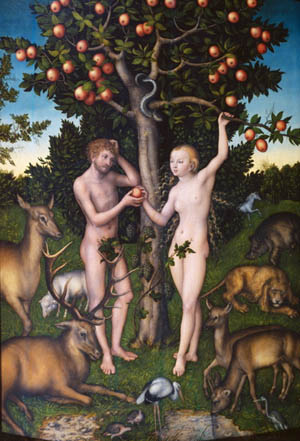
(eve91.jpg)
"Adam and Eve" by Lucas Cranach the Elder, 1526.
He should've put bananas, instead of apples.
(translated by Kato)
SOURCE: 23-25ページ 『バナナの世界史』
著者: ダン・コッペル 訳者: 黒川由美
2012年6月3日 第1版第2刷発行
発行所: 株式会社 太田出版
"Banana" by Dan Koeppel
After this translation, the Bible came to be read by more people.
During the following six centuries, the Bible began to be translated in other languages.
Then, in 1455, Johannes Gutenberg invented the printing machine, which made it possible that the Bible came to be printed in large quantities for the first time.
The Gutenberg Bible was an exact copy of the faithful Latin translation made by Jerome a thousand years ago.
As in English, Latin is a language in which there are homonyms that share the same pronunciation but have different meanings.
When Jerome translated the Hebrew word "fruit of knowledge of good and evil" into Latin, he picked “malum” for it.
According to the biblical archaeologist Shuneia Levin, its meaning is close to "malicious."
“Malum” can also be translated as "apple" since it is a word derived from the Greek word "melon" that originally maens "apple."
The Renaissance painters who read the Gutenberg Bible interpreted the word to refer to apple, and began to draw an apple, instead of a banana, in a picture of the Garden of Eden.

(eve91.jpg)
"Adam and Eve" by Lucas Cranach the Elder, 1526.
He should've put bananas, instead of apples.
(translated by Kato)
SOURCE: 23-25ページ 『バナナの世界史』
著者: ダン・コッペル 訳者: 黒川由美
2012年6月3日 第1版第2刷発行
発行所: 株式会社 太田出版
"Banana" by Dan Koeppel

But I'm still in doubt.

I can understand your doubt. Let me ask you this question.
What is it?
Where is the Garden of Eden?
I think it was somewhere in the Middle East.
According to the Book of Genesis, the Garden of Eden was surrounded by four rivers---the Tigris, the Euphrates, the Pishon, and the Gihon. In the early 1980s, using satelite-captured pictures, an archaeologist located the Pison and the Gihon, which are now at the bottom of the Persian Gulf. In the old days, the Garden was climatically well-suited for bananas, but not for apples. Even today, the Middle East is well-known as one of the main producers for bananas, but not apples.
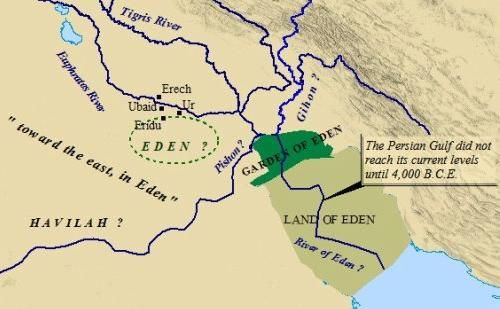
(edenmap.jpg)
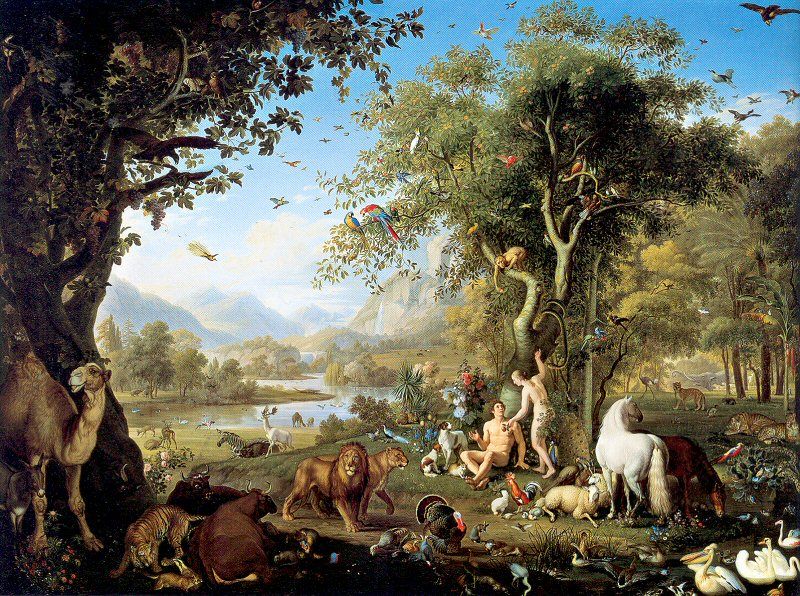
(garden02.jpg)

But you can find apples even in the Middle East.

I know, but not many apples. As a matter of fact, in old days, they couldn't grow apples in the Middle East. Only with the modern technology can they grow apples nowadays over there.
I see... Tell me, Kato, who on earth drew an apple in the picture of the Garden of Eden for the first time?
Hugo van der Goes did.
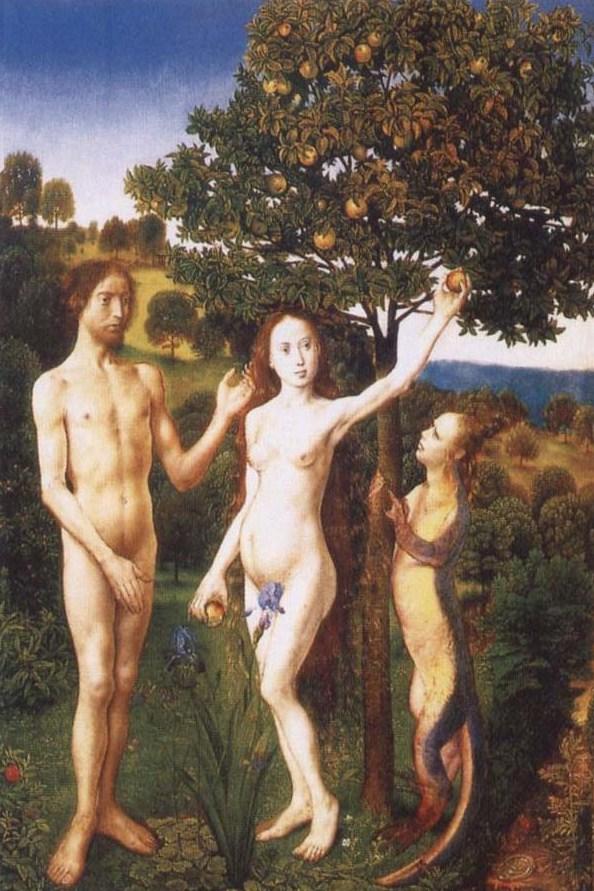
(hugo02.jpg)
Hugo van der Gose
(Circa 1440 - 1482)
Painter of early Flemish school.
Born in or near Ghent, van der Goes was enlisted as a member of the painters' guild of Ghent as a master in 1467.
The following year he was involved in the decoration of the town of Bruges in celebration of the marriage between Charles the Bold and Margaret of York.
He provided heraldic decorations for Charles's joyeuse entrée to Ghent in 1469 and later in 1472.
He was dean of the Guild of Saint Luke in Ghent from 1474 till 1476.
SOURCE: "Hugo van der Goose"
Free encyclopedia "Wikipedia (Wikipedia)"
(Circa 1440 - 1482)
Painter of early Flemish school.
Born in or near Ghent, van der Goes was enlisted as a member of the painters' guild of Ghent as a master in 1467.
The following year he was involved in the decoration of the town of Bruges in celebration of the marriage between Charles the Bold and Margaret of York.
He provided heraldic decorations for Charles's joyeuse entrée to Ghent in 1469 and later in 1472.
He was dean of the Guild of Saint Luke in Ghent from 1474 till 1476.
SOURCE: "Hugo van der Goose"
Free encyclopedia "Wikipedia (Wikipedia)"

Because van der Gose painted apples in the Garden of Eden, the people who saw his picture came to believe that Adam and Eve ate an apple, instead of a banana. Since then, almost all the painters drew apples in the picture of "Adam and Eve."
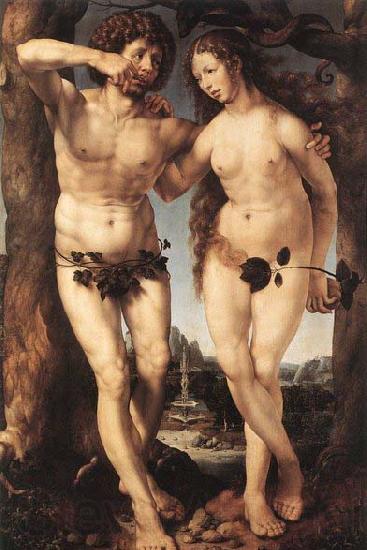
(eve904.jpg)
ADAM AND EVE by Jan (Mabuse) Gossaert (1478-1532)
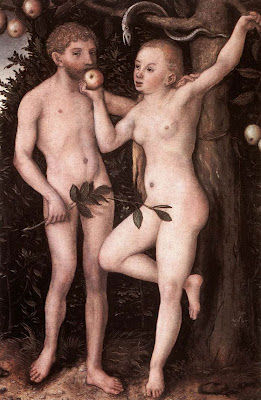
(eve905.jpg)
Adam and Eve by Lucas Cranach the Elder (1472-1533),
the German Renaissance painter.
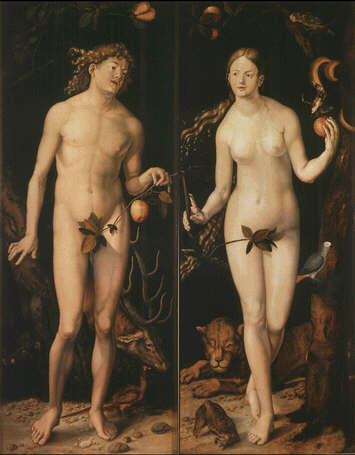
(eve907.jpg)
ADAM AND EVE by Hans Baldung Grien (1484-1545)
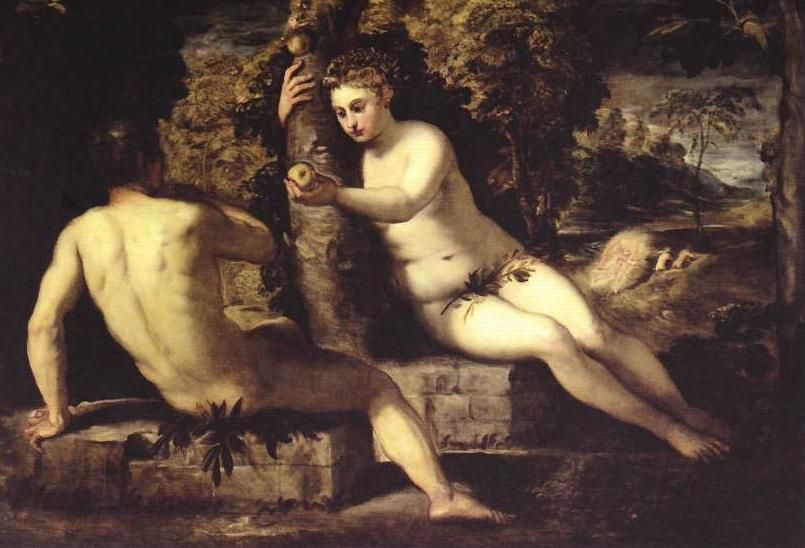
(tintoretto.jpg)
ADAM AND EVE by Tintoretto (1518-1594)
The Fall of Man, c. 1550
Canvas, 150×220 cm
Galleria dell’Accademia, Venice
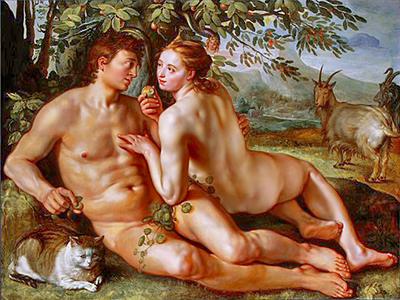
(eve903.jpg)
ADAM AND EVE by Hendrik Goltzius (1558-1617)
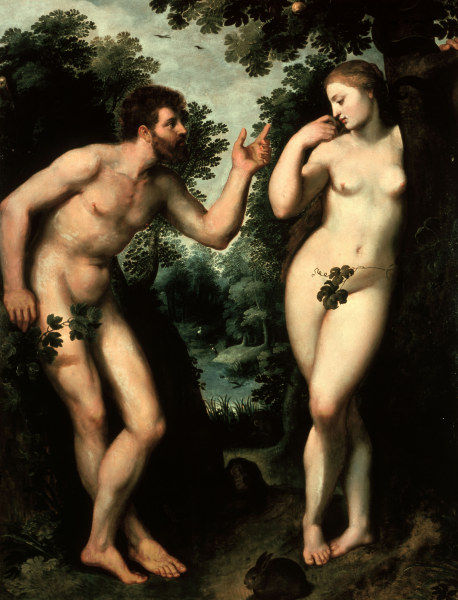
(eve901.jpg)
ADAM AND EVE by Peter Paul Rubens (1577-1640)

(eve906.jpg)
ADAM AND EVE by Hans Thoma (1839-1924)
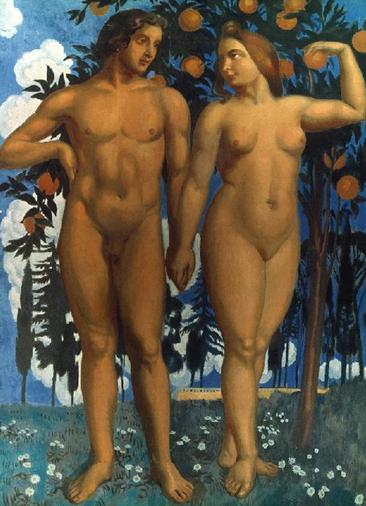
(eve902.jpg)
ADAM AND EVE by Maurice Denis (1870-1943)

For more than four centuries, the painters have drawn apples in the picture of Adam and Eve.

Then who the heck started to tell the world that Adam and Eve ate a banana, not an apple?
The man in the following picture did.
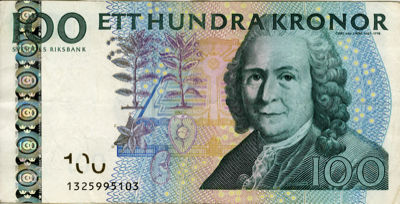
(linne02.jpg)

Who on earth is this man?

You might've heard of his name, Diane. His name is Carl Linne, the naturalist who was born in 1707 and died in 1778. He is world-famous called the "father of modern taxonomy."
I think I heard his name in my biology class at high school. He started to tell the world that Adam and Eve ate a banana, not an apple, didn't he?
I do not know whether or not he educated the Pope. In any case, Linne was a devouted Christian, and believed that it was God's calling for him to make a perfect inventory on the creation of God. Moreover, Linne believed the existence of Eden as well as that of bananas. You can find the following interesting passage in the book.
The yellow sweet banana was gaven the scientific name of "Musa sapentium" from the Latin word which means "knowledge" after the tree of wisdom that knows good and evil.
In addition, the green banana (a.k.a "plantain" used as a cooking) was named "Musa paradisiaca," that is, "banana paradise."
Genus "Musa" that Linne named comes from the Arabic word "mauz," which means the banana.
It is understandable because bananas appear in the holy garden depicted in the Koran---the holy scriptures of Islam written in Arabic.
In the Koran, the tree in the forbidden Eden is called "talh," which is usually translated as "tree in a paradise," or more directly "banana tree."
The scriptures of Islam indicates, "The fruit grows abundantly in the shade of luxuriant foliage... and you can see the fruit in all the year round."
This depiction certainly matches the way bananas grow in the tree.

(banana83b.jpg)
(translated by Kato)
SOURCE: 24-26ページ 『バナナの世界史』
著者: ダン・コッペル 訳者: 黒川由美
2012年6月3日 第1版第2刷発行
発行所: 株式会社 太田出版
"Banana" by Dan Koeppel
In addition, the green banana (a.k.a "plantain" used as a cooking) was named "Musa paradisiaca," that is, "banana paradise."
Genus "Musa" that Linne named comes from the Arabic word "mauz," which means the banana.
It is understandable because bananas appear in the holy garden depicted in the Koran---the holy scriptures of Islam written in Arabic.
In the Koran, the tree in the forbidden Eden is called "talh," which is usually translated as "tree in a paradise," or more directly "banana tree."
The scriptures of Islam indicates, "The fruit grows abundantly in the shade of luxuriant foliage... and you can see the fruit in all the year round."
This depiction certainly matches the way bananas grow in the tree.

(banana83b.jpg)
(translated by Kato)
SOURCE: 24-26ページ 『バナナの世界史』
著者: ダン・コッペル 訳者: 黒川由美
2012年6月3日 第1版第2刷発行
発行所: 株式会社 太田出版
"Banana" by Dan Koeppel

I see... Bananas appear in the Koran, don't they?

That's right. The scriptures of both Islam and Christianity come from the Old Testament. Diane, look at the following picture of "Adam and Eve" again.

(eve907.jpg)

Adam and Eve are hiding their private parts with the fig leaf.

Yes, I can see that. So what?
Why the fig leaf? Diane, have you ever wondered how come both of them had to hide with the fig leaf---among all other leves?
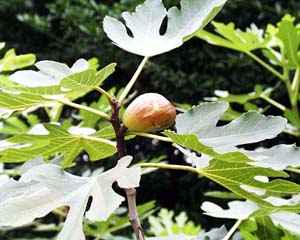
(ichijiku2.jpg)

Well ... I suppose there was a fig tree nearby, so they happened to pick its leaves.

Take a close look at the fig leaf. There are some slits in the leaf. You can see the private parts through the open gaps, can't you?
That is because you're so keen to take a close look at those parts.
I'm not so keen, Diane. Look! The private parts are visible through the open gaps. You see... both ate an apple from the tree, so it is narural for them to pick up leaves from the apple tree. Don't you think so? Yet, they hide their parts with the fig leaf. It is unnatural, isn't it?
I see... it would be more natural for them to pick up some leaves from the apple tree---not from the fig tree.
Yes, that's what I'm talking about.
Maybe, a fig tree happened to grow by the apple tree.
It sounds too contrived. People wouldn't believe that, I guess.
Kato, you don't like fig trees, do you?
Yes, I like those, but as a matter of fact, in the ancient days, a banana was called "fig."
No kidding!
I'm dead serious. The above book says that Alexander the Great sent a letter to Aristotle about the discovery of "fig" when he saw bananas in India.
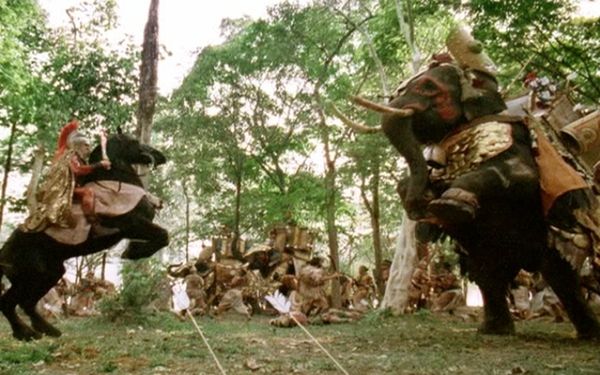
(alex009.jpg)

When the Spanish explorers came across bananas in the New World, they recorded those bananas as "the fig."

But, I can't still believe that "fig" in old days means "banana."
Believe me, Diane. They say, "Those who believe are saved."
Only the Japanese believe it, I guess.
To tell you the truth, in the ancient Hebrew, a banana was called the "fig." Besides, the forbidden fruit is written as the "fig of Eve"---that is, banana of Eve.
I still can't believe this.
Diane, look at the following picture!
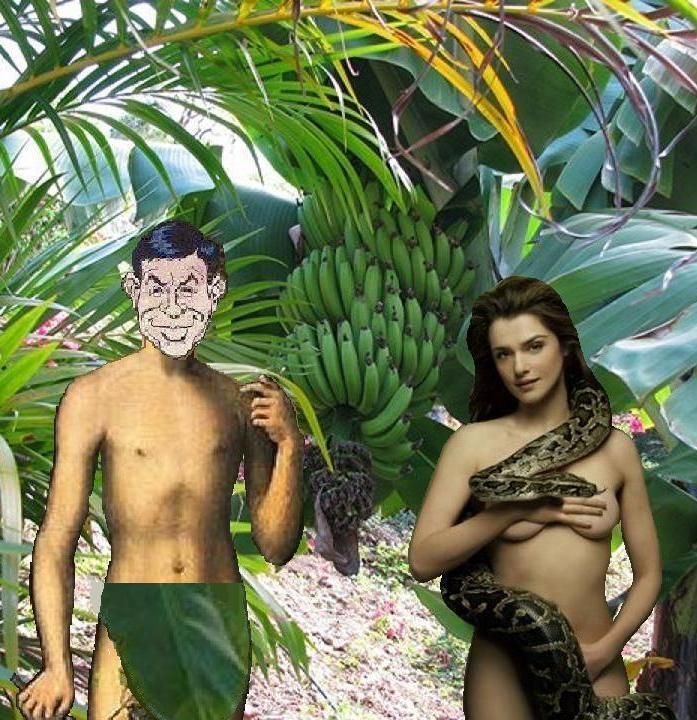
(banana82f.jpg)

This is a conclusive evidence because a banana leaf is much better than a fig leaf when you hide your private parts. A fig leaf is not big enough to hide your pussy.

【Himiko's Monologue】
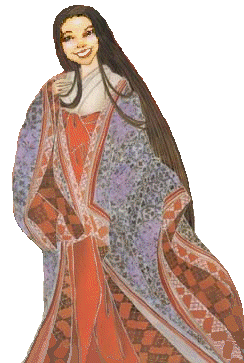
What an amazing story it is!
Yes, a fig leaf is too small to hide my pussy.

(himiko202.jpg)
In any case, I hope Kato will write another interesting article soon.
So please come back to see me.
Have a nice day!
Bye bye ...


What an amazing story it is!
Yes, a fig leaf is too small to hide my pussy.

(himiko202.jpg)
In any case, I hope Kato will write another interesting article soon.
So please come back to see me.
Have a nice day!
Bye bye ...


If you've got some time,
Please read one of the following artciles:

(juneswim.jpg)
■"Halifax to Vancouver"
■"A Thread of Destiny"
■"Fujiyama Geisha"
■"Beaver Lake"
■"God is Near!"
■"Holy Cow@Rose Garden"
■"Vancouver Earthquake"
■"Birthplace"

■"KIFF"
■"You Love Japan, eh?"
■"Eight Bridges"
■"First Love"
■"Fright on Flight"
■"Boy's Movie"
■"From Summer to Eternity"
■"Sōseki & Glenn Gould"

(biker302.jpg)
■"Dream Dream Dream"
■"In Search of Your Footprint"
■"Little Night Music"
■"Merry X'mas"
■"Happy New Year!"
■"Long live Diane!"
■"Mona Lisa"
■"Flu Shot"
■"Selfish TD Bank"
■"Talk with Mozart"

■"Bliss for Diane!"
■"Romantic Bohemian"
■"TD Bank or Mozart?"
■"Diane@TD Bank"
■"Tear Jerker"
■"Diane in Chorus Line"
■"Pork or Friend?"

■"Easter Bloopers"
■"Beauty is Heart-deep"
■"Romance@South Pacific"
■"Art Gallery"
■"Diane Hypatia"
■"Cherry and Silk"
■"Price of Your Life"
■"Elephant Cries"


Hi, I'm June Adams.
The Garden of Eden is the biblical "garden of God", described most notably in the Book of Genesis (Genesis 2-3), but also mentioned, directly or indirectly, in Ezekiel, Isaiah and elsewhere in the Old Testament.
In the past, the favoured derivation of the name "Eden" was from the Akkadian edinnu, itself derived from a Sumerian word meaning "plain" or "steppe", but it is now believed to be more closely related to an Aramaic root meaning "fruitful, well-watered."
The Eden of Genesis has been variously located at the headwaters of the Tigris and Euphrates in northern Iraq, in Africa, and in the Persian Gulf.
The Eden in Ezekiel appears to be located in Lebanon.
For many medieval writers, the image of the Garden of Eden also creates a location for human love and sexuality, often associated with the classic and medieval trope of the locus amoenus.
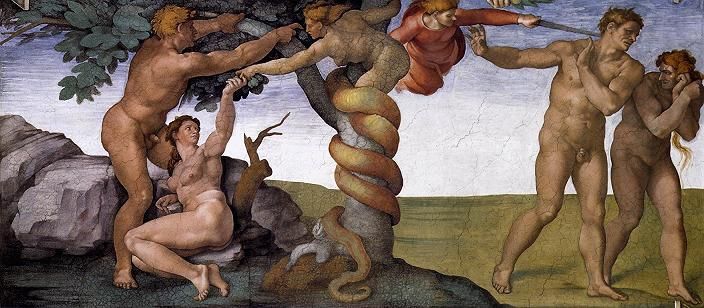
(eden009.jpg)

ところで、愛とロマンに満ちた
レンゲさんのお話をまとめて
『レンゲ物語』を作りました。
もし、レンゲさんの記事をまとめて読みたいならば、
次のリンクをクリックしてくださいね。
■『愛とロマンのレンゲ物語』

■『軽井沢タリアセン夫人 - 小百合物語』
とにかく、今日も一日楽しく愉快に
ネットサーフィンしましょうね。
じゃあね。







0 件のコメント:
コメントを投稿